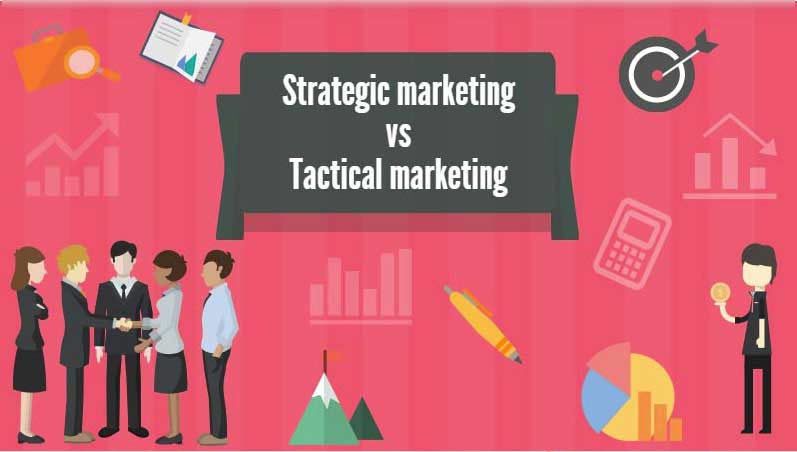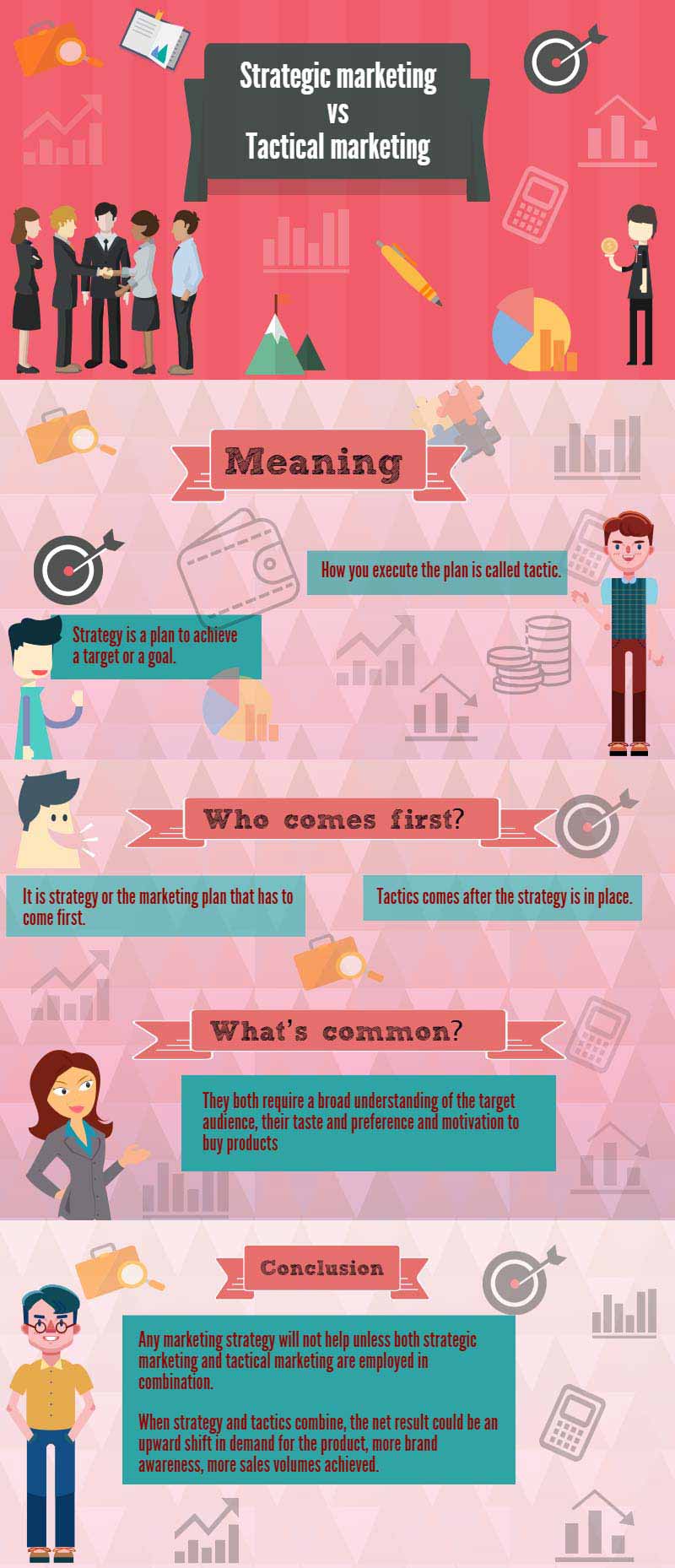Updated April 24, 2023

Difference Between Strategic Marketing vs. Tactical Marketing
Some words in business and marketing appear to have been directly taken from the military or the armed forces. Even the word strategy has more to do with warfare than daily living. Not to forget guerilla, ambush, frontline, Strategic Marketing, and tactics.
Many people use the word strategy very commonly. Politicians talk about it. Religious leaders speak about the approach to outclass the communal elements in society. Police also need a strategy to curb theft, goondaism, or burglary in an area.
Most people use tactics to relate to the strategies. In addition, they say politicians use religious cards to get the votes of minorities and so on.
In simple terms, strategy marketing is a plan to achieve a target or a goal. It could achieve more sales volume in rural areas. It could be getting more women’s votes in the Assembly election. Strategy marketing could also emerge as number one in the cosmetics market, and so on.
The tactic is how you can execute the plan. Politicians may freely distribute sarees in an area to gain women’s votes. Likewise, to emerge as the leader in the cosmetics industry, a company may spend heavily on mass media campaigns and sponsoring beauty pageants.
When strategy and tactics combine, the net result could be an upward shift in demand for the product, more brand awareness, and more sales volumes. Or a company may adopt competitive pricing to stay ahead of the others in the industry or to achieve maximum sales volume.
The question arises which should come first, tactics or strategy? It is a strategy or marketing plan that has to come first, followed by tactics. However, it is not to belittle the tactics part of marketing.
According to Jim Joseph, marketing expert, and author, tactics are important because they connect with the customers and motivate them to buy.
Head To Head Difference Strategic Marketing vs Tactical Marketing (Infographics)
Below are some of the differences given.
Strategy comes first
Most countries have a Planning Commission, just as in India, which identifies the long-term goals of developing infrastructure, resources, housing, raising employment, and raising the educational levels of poor and rural people.
In a federal system, the states also play a role in identifying projects to carry forward and the means to raise resources for them, either through union government grants or loans.
Developing a marketing plan or strategy is the first step to getting into the market for companies. Unlike a business plan, a marketing plan is developed to win and retain customers. It also spells out the tactics and tools to achieve it.
Both strategy and tactics require a broad understanding of the target audience, their taste and preference, and their motivation to buy products. They should also understand the status of the industry, the company’s status, and that of the competitors.
1. Market share and strength of the company
Your market share in the industry and how you fare against the competition are vital for making a marketing plan.
A situation analysis requires a comprehensive SWOT analysis (Strengths, Weaknesses, Opportunities, and Threats).
Market strength refers to the number of your brands in the top five selling categories. Weaknesses could be a saturated market or a lack of experienced people in marketing and sales.
Opportunities could include legislative changes, new markets opening up, or the disintegration of a market leader.
The product must be positioned in the market- entry, mid, or premium. It depends on your competition, which buyers will likely buy the product, and at what price.
2. Identify the target audience
A marketer should be able to identify the target audience for its products and services. It should be defined in demographics, age, sex, family, income, and lifestyle levels.
Are they conservative or traditional? Do they have higher disposable incomes and motivation to spend more? Are they business class, salaried, and at marginal income levels?
3. Define Long-term marketing goals
A marketing goal can be the number one position in geography or concerning a particular brand, or it could be to achieve more sales. But it is very important to specify in quantitative terms, say a 10 or 25% increase in sales.
4. Develop a Marketing Communication strategy
Once the product has been developed and the target audience has been defined, the next step is to devise marketing communication strategies to reach the target and persuade them to act.
It could be through mass media advertisements and social media campaigns (Twitter, Facebook, Pinterest, Reddit). The marcomms strategy outlines the tactics for achieving the objectives. However, the execution of the tactic brings the desired impact on the product and the market.
5. Create a marketing budget
At the outset, whether it is a start-up or an established one, creating annual marketing budgets is of paramount importance. The brand may also require a mix of newspaper, television, social media, hoardings, and banners to build the brand and increase sales.
It is very important to keep the margin on sales as a barometer of how much should be spent on advertising promotion. Spending too much on advertising in industries with thin margins may not be the desired tactic.
For instance, in drinking cola, where the production costs are low compared to the selling price, companies can afford to raise the marketing budget to increase market share.
Efforts should be taken to keep marketing costs within the budgeted costs, or else it may be difficult to get finance approval.
Tactics-Everything revolves around the 4 P’s
You should know the four P’s of marketing- Product, Pricing, Place, and Promotion. However, the market is complex and is not easily understood by the common person.
Strategic marketing involves adjusting the price of your price position, place of marketing, and perhaps the product itself. For example, Maruti Suzuki Ltd, India’s leading seller of passenger cars, re-launched its premium brands that didn’t succeed in the market through design changes and re-positioning the models in a new showroom called Nexa.
According to Suzuki, the results of the S-Cross premium cross-over brand clocked sales of 50,000 in six months after relaunch.
1. Pricing basic tactic
Pricing is the basic tactic adopted by companies to attain their objectives. However, it is also the most complex of the tactics to be pursued by marketers.
High prices could dissuade buyers from the product and attract them to competitive offers. While a price perceived as too low may cause buyers to doubt its quality and value.
Contrary to popular perception, the Price is not calculated on the cost plus a reasonable profit. It is based on the brand image created in the consumer’s minds and a level the market is willing to bear.
According to experts, pricing as a marketing instrument is difficult to leverage effectively as it involves decision-making horizontally and vertically within an organization.
Pricing tactics are usually based on supply, demand, elasticity, and other parameters. Price elasticity refers to a percentage change in quantity demanded in response to a change in price upward or downward.
Pricing has greater leverage on products with high elasticity of demand as it can cause a significant increase or decrease in revenue. There are two types of pricing –strategic Marketing and tactical pricing.
Strategic Marketing pricing takes into account the long-term profit objectives of the organization. In contrast, tactical pricing is about achieving short-term objectives such as festival offers, end-of-season sales at 50% off, etc.
2. Product dynamics
Because of the competition, the product may have to be altered or abandoned, and a new product is developed. Mosquito repellents in India were initially smoke coils which caused many people breathing problems and littered the place with ash.
Thereafter, companies started to develop liquid repellents that worked on the electric current by slowly discharging the liquid and smell, driving away mosquitoes.
3. Place and geographical targeting
Moreover, most products are sensitive to geographies and cultural differences. What sells in the rural market may not appeal to the urban market.
Low-priced cars may be more suitable for emerging markets than developed markets. At the same time, places with extreme cold, humidity, and hot conditions require different products specifically for that region.
4. Promotions and the changing technologies
Marketing promotion involves communicating the brand message to consumers through mass media, email campaigns, social media, hoardings, banners, events, and trade fairs.
Marketing communication activities are part of the marketing strategy to achieve certain long-term branding objectives, sales, market share, and related objectives.
The millennials born in the US between 1980 and 2000 have a different mindset toward buying, spending, and consumption patterns. They comprise 79 million people with a purchasing power of $170 bn a year.
This group prefers online, social media, and mobile technologies. Therefore, more effort needs to be taken to address this target group. What sets apart Millennials from boomers and Gen Xers is they tend to share everything with friends online.
Therefore, brands can capitalize by giving millennials satisfying customer experiences. Brands can also allow them to share a tweet about the company and let others know they have bought your product.
Conclusion
Changing market dynamics requires a change in marketing strategies and tactics. In the 1970s, Arm & Hammer baking soda suffered a jolt as its household demand declined.
Promotes Church & Dwight Inc devised a strategy to make current customers pick up the yellow box at the supermarket and use more baking soda. It was to sell Arm & Hammer as a deodorizer for the fridge-which led the company to develop environment-friendly cleaning products.
The company maintained its yellow box with the red Arm & Hammer logo, which is instantly recognizable with a long history since the 1860s.
Sometimes a refusal to change with the changing times can cost a product. For example, the Ambassador Car of yesteryears had nearly 90% of the market share to new sleekly designed cars.
Domino strengthened its market share in pizzas with its 30-minute delivery strategy. Any company finds it tough to compete on product quality. Therefore, they could evolve a USP based on delivery and entire tactics, then start revolving around that strategy.
Thereafter, many other brands, including KFC and MacDonald’s, seem to have implemented this strategy effectively.
In many ways, the modern markets resemble the war fields, although not physically, where there is a battle between brands and unorganized players. Hence, each company works on a strategy and measures (tactics) required to execute it.
According to Mikal E Belicove, GSOT- goal, strategy. Objectives and tactics are the best ways to conceptualize a marketing plan. A goal is a broad primary outcome, and strategy is the plan. The objective is the measurable step. At last, tactics are the tools and techniques used to implement the strategy.
Any marketing strategy will not help unless strategic and tactical marketing is combined.
The prerequisites for a successful campaign are knowing the status of the company vis-as-vis competition (market share), developing marketing communication, and understanding the target audience.
With a proper understanding of all the above factors, any campaign may end up being a failure and not able to achieve its objectives.
Strategic marketing is vital for achieving the company’s long-term goals. They also adopt tactical marketing on an Adhoc basis and risk being unable to convert potential leads.
Disruptive technologies, recessionary market conditions, new competition from other industry verticals, and competition within the industry are all factors that could impact the fortunes of brands. Hence, marketers need to be constantly on their toes to stay ahead.
No marketer would be wise enough to ignore the inbound marketing strategies now in vogue thanks to rising internet, websites, blogging, and search engine optimization (SEO) techniques.
Recommended Articles
This article has been a Guide to Strategic Marketing vs Tactical Marketing. Here we also discussed the head-to-head difference along with infographics. You can also go through our other suggested articles to learn more –

